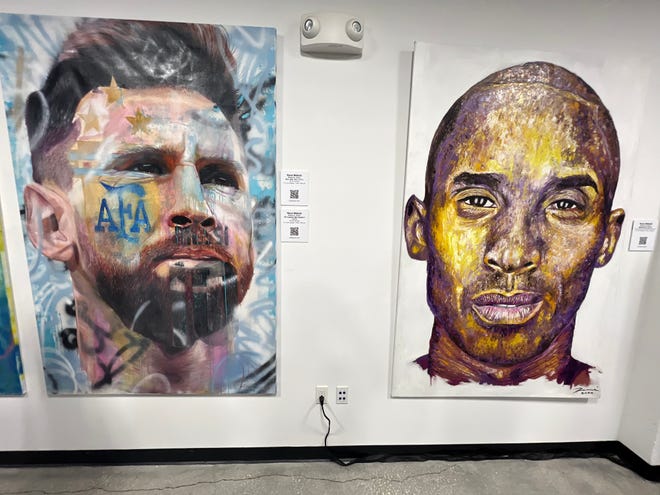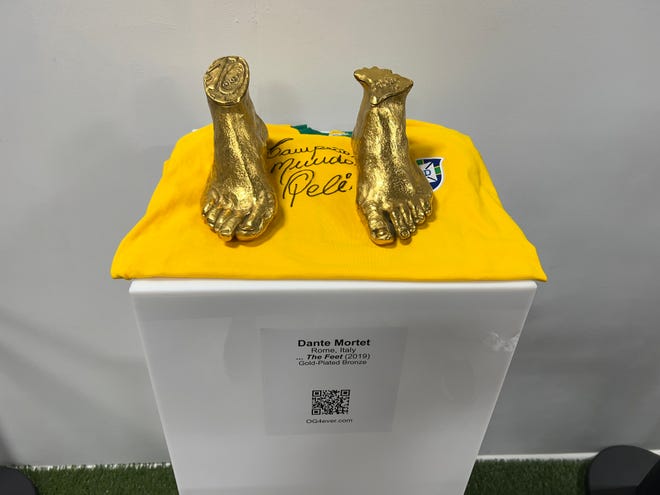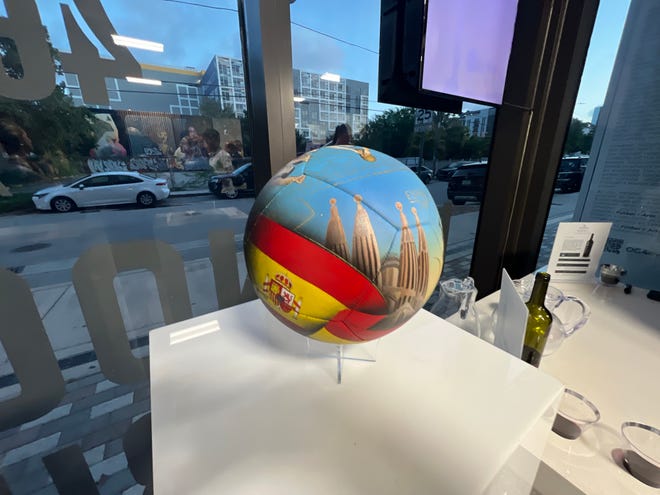
2024-07-15 22:15:01
WYNWOOD — The world’s top soccer players will take the field from Miami to Berlin Sunday. But at a gallery in this trendy, popular Miami district it’s the sport as art that is on display.
Wynwood Art Experiences is featuring an exhibit, which runs through Aug. 31, that includes a bronze sculpture of Brazilian icon Pelé’s feet and soccer balls finely painted to honor past World Cup winning national teams. The Fútbol = Arte display features the work of Italian sculpture Dante Mortet and painters Lili Cantero of Paraguay, Rene Makela of Spain and Carling Jackson of Canada.
Mortet sculptured the actual feet of the late Brazil legend referred to as the king of soccer. He said fútbol, known as soccer in much of the planet, is the “game of the world” and “soccer is a form of art.” Mortet played fútbol professionally and said he still misses the field, the camaraderie of the locker room and the electric atmosphere that runs through the stands in stadiums.
Today, Mortet labors in the workshop that was started by his family 150 years ago. He plies his craft the old-fashioned way, with eyes and hands, no computers or 3-D printers.

A fifth generation sculptor, Mortet, who lives in Rome, said he is partly inspired by the longevity of the bronze statues that dot the Italian capital. He notes they speak to ancient past, drawing attention to history in both the subjects they depict and the technique used to create them.
He draws an analogy to today’s fútbol heroes.
“Who are the modern gladiators? The modern gladiator is the fútbol player,” he said. “From there is born the idea of the scuplture of the feet of the contemporary gladiator. To transform the feet of the player into a sculpture in bronze forever.”
Perhaps in a mllennia, a video of goals scored by Pelé, or Diego Maradona or even Lionel Messi may or may not be around. But history, he said, has proven the endurance of works of art, both in the hands of appreciative collectors or in the public square.

“For a soccer player, when you transform this idea into a sculpture, you give it a soul and you realize that it could be something that will continue telling the story forever,” Mortet said. “That’s what has attracted me to this form of art and expression.”
Cantero, who painted a collection of regulation soccer balls to honor past World Cup champions including Argentina, Spain, Germany and England,
Although she wishes she were painting a ball honoring her nation’s team, Paraguay, Cantero said is she attracted to the sport by the way it unites people of all cultures and backgrounds. She added fútbol is its own universal language, which cuts across barriers and creates an emotional connection between players and fans.
“As an artist, I am fascinated by how fútbol can evoke such intense emotions and how those moments can be captured and expressed through art,” she said. “Furthermore, the aesthetics of sport, with its dynamic movements and rich history, offer an inexhaustible source of inspiration for my works.”
Cantero said she chose the ball as her canvas because it represents the focus of action on the field. She said painting a soccer ball allowed her to transform an “everyday object into a unique work of art” that celebrates the sport in its most basic form. And it was a challenge, she added.

“The spherical shape of the ball presents an interesting artistic challenge, forcing me to consider composition and design in three dimensions, which adds an additional layer of creativity and complexity to the project,” she said.
Aaron Davidson, who organized the exhibit at the gallery, said he got the idea of merging fútbol as culture when a former girlfriend once told him the sport was not culture. He also wanted to create an exhibit that features “real and true art,” as opposed to memorabilia.
He said he wants to spotlight generational art that is appreciated and embraced like a family heirloom because it means something, emotionally and sentimentally, and not merely based on its potential speculative wealth or price.
“There is a desire to return to what is real, the sentimental and have art for the sake of art,” he said. “Generational art is important art because it has personal significance for the buyer, the collector. The idea of this gallery is to be a sports art gallery,
Antonio Fins is a politics and business editor at The Palm Beach Post, part of the USA TODAY Florida Network. You can reach him at af***@****st.com. Help support our journalism. Subscribe today.






